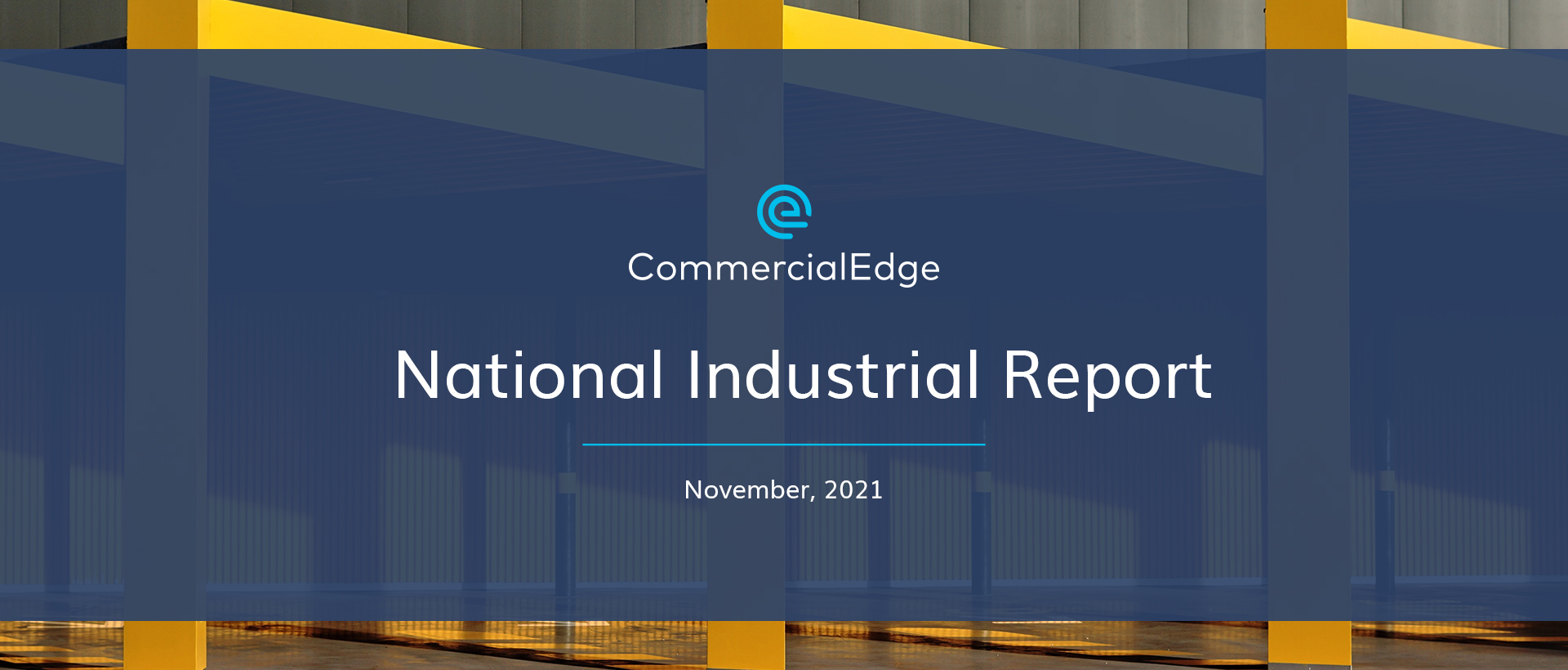Key Takeaways:
- National average rent for industrial space climbs to $6.37/sq. ft. in October, up 3.9% Y-o-Y
- Vacancy across top 30 industrial markets edges up 30 basis points M-o-M to 5.9%
- October closes with nearly 523MSF of industrial space in supply pipeline
- Year-to-date investment sales top $51B, outstrip 2020’s total deal volume
Port Markets & Sunbelt Record Strongest Rent Expansion in 12 Months
The average rent across the top 30 U.S. markets climbed to $6.37 per square foot in October, up 3.9% year-over-year (Y-o-Y) and slightly above the September national average. Consistent with trends observed in previous quarters, port markets and the Sunbelt commanded the highest October rent growth. At the same time, the Inland Empire led the U.S. with a 6.6% hike over the previous 12 months, followed by Nashville with 6.2%, while Los Angeles and New Jersey both clocked in at 5.7%.
As the hottest U.S. market outside of California, New Jersey’s industrial fundamentals are driven by booming activity in the ports of New York and New Jersey. New lease premiums in New Jersey cost $2.54 more per square foot than the market average. Overall, new leases were signed on average at $7.19/sq. ft. across the nation’s top 30 markets.
Meanwhile, rent expansion in Midwestern markets continued to be sluggish, with Kansas City rates actually slipping .2%, while St. Louis rents inched up just 1.2%. Surprisingly, two port markets were also on this end of the spectrum, with Boston rents up 1.9% and Houston up only 1.7%.
Read to the end and download the full November 2021 report for updated lease rate and vacancy stats for all major U.S. markets.
Inland Empire Vacancy Contracts to a National Low of 1%, Columbus Leads Midwest at 1.9%
As industrial vacancy continues to tighten at a steady clip, the Inland Empire led again with the lowest vacancy in the country, at a mere 1%, well below the 5.9% national average. While not a port market itself, the ample distribution hub assumes a considerable share of shipping volume received through the ports of Los Angeles and Long Beach.
Los Angeles closed October with a 2.9% vacancy rate, closely followed by New Jersey at 3.4% and Orange County at 3.7%. Certain landlocked hubs stood out with markedly lower rates than the U.S. average, with the vacancy rate in Columbus resting at 1.9% and in Nashville at 2.8%.
Nationally, More Than 520MSF in the Pipeline, Demand Swells at Historical Pace
While historical levels of new supply are currently under construction, with 522.5 million square feet underway nationwide as of October, new industrial space might not be able to match the ever-expanding demand. The supplemental 540.3 million square feet in the planning stages may move the needle, but ongoing labor and material shortages are still likely to impact overall delivery timelines.
Dallas-Fort Worth continues to lead the top 30 industrial markets in the U.S. in terms of new supply, with 35.3 million square feet under development as of October. Phoenix, on track to become the semiconductor manufacturing capital of the U.S., came in second with 29.7 million square feet, followed by Chicago’s 28.5 million-square-foot pipeline.
The largest development pipelines in terms of stock basis are in Phoenix at 11%, and in Indianapolis, where the 23.4 million square feet of new supply will account for 7.6% of inventory. The Inland Empire’s pipeline — 22.5 million square feet representing 3.8% of existing stock — is likely to get absorbed immediately after completion, given the market’s tight vacancy.
Three California Markets Top $200 Per Square Foot Average, Seattle Ranks Fourth in the U.S.
Industrial pricing remains on an ascending trajectory, with the average sale price reaching $110/sq. ft., up 25% compared to 2020. As heightened investor interest continues to drive transactional activity, investment sales amounted to $51.2 billion year-to-date through October. With two months still left of the year, sales volume has already exceeded 2020’s total transactional volume.
Detroit had the largest sales price increase among the top 30 U.S. markets, up 84% Y-o-Y. Nashville ranked second in terms of Y-o-Y price growth with 50%, followed by New Jersey at 49%.
Meanwhile, prices topped the $200/sq. ft. average in four markets, with Orange County in the lead at $294/sq. ft. The Bay Area average came in second with $233/sq. ft., followed by Los Angeles with $221/sq. ft. and Seattle with $204/sq. ft.
Download the complete November 2021 report for a full picture of how U.S. industrial markets fared in the first 10 months of the year, including insights on industry and economic recovery fundamentals.

You can also see our previous industrial reports.
Methodology
CommercialEdge added new markets to the National Industrial Report as Yardi Market Insight has increased its coverage to more than 50 markets in recent months. As such, the national numbers in this and future reports are not comparable to past issues.
The monthly CommercialEdge national industrial real estate report considers data recorded throughout the course of 12 months and tracks top U.S. industrial markets with a focus on average rents; vacancies (including subleases but excluding owner-occupied properties); deals closed; pipeline yield; and forecasts, as well as the economic indicators most relevant to the performance of the industrial sector. For a detailed methodology, download the full report above.
Stay current with the latest market reports and CRE news:
Latest Posts
Recent Reports
Anticipated Office Distress to Materialize in 2025
The wave of distress anticipated since the peak of the pandemic has begun to materialize at the beginning of 2025.
Tariff Uncertainty Brings Short-Term Disruptions to Industrial Sector
Tariff uncertainty will lead to delayed leasing decisions from industrial occupiers, while also increasing construction costs
Coworking Continues to Gain Traction Amid Shifting Market Dynamics
Coworking spaces across the nation continue to grow in numbers and popularity, bringing more options to the office sector amid ongoing shifts.







